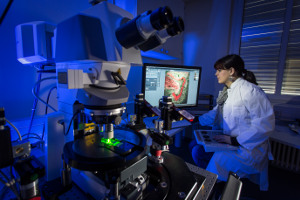Project B05
GABA interneurons as mediators of cognitive flexibility

Prof. Dr. Oliver Stork

Negative experiences lead to avoidance of stimuli and situations that are associated with the negative reinforce, and to the suppression of other ongoing behavior. This reaction is rapidly acquired and long remembered. Two brain regions, the amygdala and the hippocampus, are of fundamental importance for the forming of such memories for aversive experiences. Our project aims at identifying and functionally characterizing GABAergic local circuit neurons in amygdala and hippocampus and their role in controlling the stability and specificity of aversive memories. Several subpopulations of these local circuit neurons exist that all use the inhibitory transmitter γ butyric acid (GABA), but differ in their morphology, their physiological properties and their neurochemical characteristics. Accordingly, these populations play distinct roles in controlling excitability, plasticity and information flow within both areas as well as the generation of behaviorally relevant network activity patterns. With a combination of behavioral, anatomical and molecular analyses we study these functions. We trace their connections and using laser microdissection and quantitative PCR methods obtain detailed molecular profiles of GABA cells and their learning-induced changes in gene expression. Moreover, we develop tools to specifically manipulate target cell populations with viral vectors and examine the effects of these manipulations on network physiology and behavior.

Thus we have identified in cooperation with TP B06 cell populations in the hippocampus that control the stability of fear memories and the salience of contextual information. Furthermore, we could demonstrate the role of GABA synthesizing enzymes and neuropeptide co-transmitters of GABAergic local circuit neurons in the stress-mediated enhancement of fear memory formation. We have identified gene products that are critical for specific phases of memory formation and memory modulation, such as the Neural Cell Adhesion Molecule NCAM and various protein kinases, and have begun to address their function in GABAergic local circuit neurons. We furthermore cooperate with TP B08 and TP B09 in the behavioral characterization of Jacob and Bassoon mutant mice and together with TP A06 and TP A08 have begun to translate our findings on GABAergic mechanisms of motivated behavior to the human level.

GABAergic neurons in hippocampal area CA1 (green) containing neuropeptide Y (red) are labeled with the retrograde tracer fluorogold (blue and yellow) injected to the amygdala. These GABAergic neurons thus appear to directly contribute to the interaction of both brain regions.